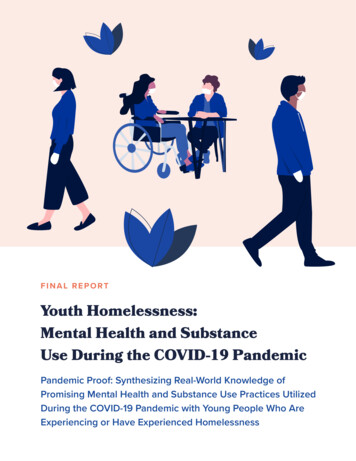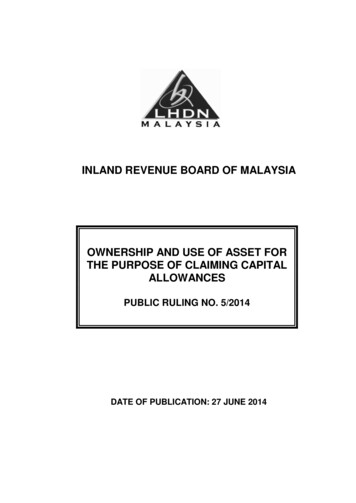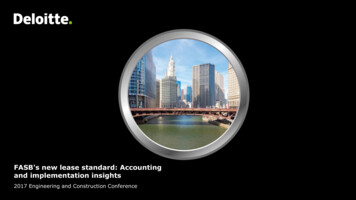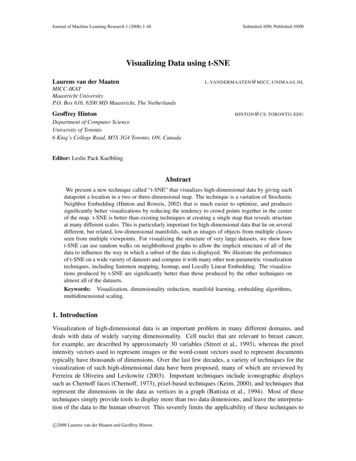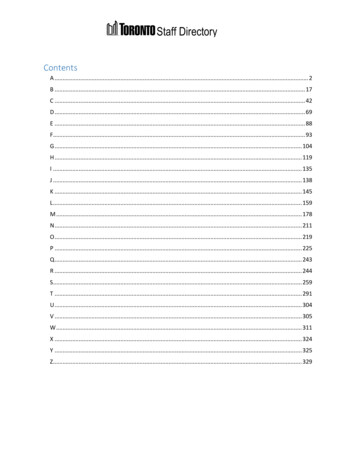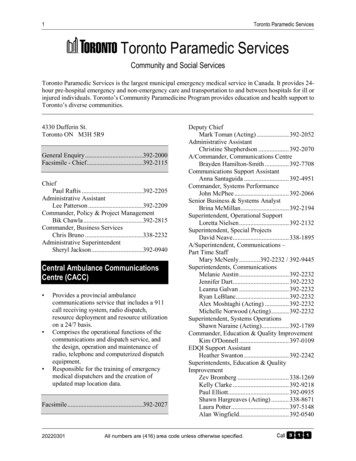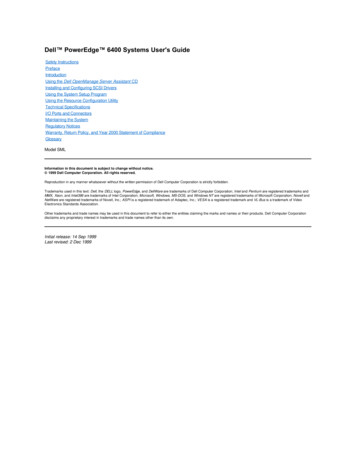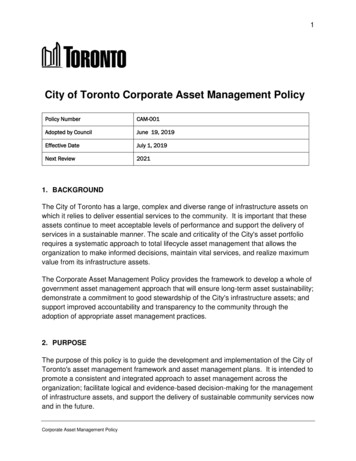
Transcription
1City of Toronto Corporate Asset Management PolicyPolicy NumberCAM-001Adopted by CouncilJune 19, 2019Effective DateJuly 1, 2019Next Review20211. BACKGROUNDThe City of Toronto has a large, complex and diverse range of infrastructure assets onwhich it relies to deliver essential services to the community. It is important that theseassets continue to meet acceptable levels of performance and support the delivery ofservices in a sustainable manner. The scale and criticality of the City's asset portfoliorequires a systematic approach to total lifecycle asset management that allows theorganization to make informed decisions, maintain vital services, and realize maximumvalue from its infrastructure assets.The Corporate Asset Management Policy provides the framework to develop a whole ofgovernment asset management approach that will ensure long-term asset sustainability;demonstrate a commitment to good stewardship of the City's infrastructure assets; andsupport improved accountability and transparency to the community through theadoption of appropriate asset management practices.2. PURPOSEThe purpose of this policy is to guide the development and implementation of the City ofToronto's asset management framework and asset management plans. It is intended topromote a consistent and integrated approach to asset management across theorganization; facilitate logical and evidence-based decision-making for the managementof infrastructure assets, and support the delivery of sustainable community services nowand in the future.Corporate Asset Management Policy
23. DEFINITIONSFor the purposes of this policy, the following definitions apply:Act: The Infrastructure for Jobs and Prosperity Act, 2015.Asset: Tangible assets that are purchased, constructed, developed or otherwiseacquired for use in the delivery of services.Asset Management: A business practice that integrates planning, finance, engineeringand operations to effectively manage existing and new assets to realize value, reducerisk and provide satisfactory levels of service to community users in a socially,environmentally and economically sustainable manner.Asset Management Plan (AMP): A long-term plan developed for the management ofphysical assets that at a minimum complies with the requirements of the Act and theRegulation, and details the characteristics and conditions of the assets, the levels ofservice expected from the assets, financing and other strategies, and planned actionsover the lifecycle of the assets to ensure assets are providing a specified level ofservice in the most cost-effective manner.Asset Management Policy: High-level statement of the principles and mandatedrequirements for undertaking asset management across the organization in anintegrated, systematic and coordinated manner that complies with the requirements ofthe Act and the Regulation.Asset Management Strategy: The high level long-term approach to assetmanagement, including asset management action plans, and objectives for managingthe assets.Asset Management System: The complete set of interrelated and interactingelements, including the asset management policy, the asset management strategy,processes, tools, data and other resources required to achieve asset managementgoals.Capitalization Threshold: The value of a municipal infrastructure asset at or abovewhich the city will capitalize the value of the asset and below which it will expense thevalue of it.City Agencies: For the purpose of this policy, the Service and Community-basedAgencies established by the City under the City of Toronto Act, 2006 as set out inSchedule A and as amended from time to time.City Corporations: All wholly-owned corporations established by City Council inaccordance with the Business Corporations Act (Ontario).Corporate Asset Management: The application of asset management principles,standards, policies and practices on a corporate level to ensure a coordinated,Corporate Asset Management Policy
3consistent, effective and organizationally sustainable approach across diverse assetgroups.Green Infrastructure Asset: An infrastructure asset consisting of natural or humanmade elements that provide ecological and hydrological functions and processes andincludes natural heritage features and systems, parklands, storm-water managementsystems, street trees, urban forests, natural channels, permeable surfaces and greenroofs.Level of Service: The condition and performance standard for a particular assetagainst which service performance may be measured.Lifecycle: The time interval that commences with the identification of the need for anasset and terminates with the disposal of the asset.Lifecycle Activities: Activities undertaken with respect to an asset over its service life,including planning, constructing, operating and maintaining, renewing, anddecommissioning, and all engineering and design work associated with those activities.Lifecycle Cost: The total cost of an asset throughout its useful life, including capitalcosts, operating and maintenance costs, rehabilitation, renewal and disposal costs.Regulation: Ontario Regulation 588/17 made under the Act.4. SCOPEThis policy applies to the lifecycle management activities of municipal infrastructureassets that are owned and/or controlled by the City of Toronto for the provision ofservices. Some of these City-owned assets maybe managed solely by the City, or byan agency or corporation of the City, or a combination of the above. This policy mayalso be used for third-party assets that the City has a significant interest in.The policy applies to all physical assets, including but not limited to infrastructure assetclasses categorized as follows: Buildings and building improvementsMachinery and equipmentWater, wastewater and stormwater linearRoads linearTransitVehiclesLand and land improvementsCorporate Asset Management Policy
45. ASSET MANAGEMENT VISION AND GOALSThe asset management vison and goals are consistent with Council's emphasis oneffective stewardship of the City resources and assets and fiscal sustainability.5.1 VisionTo ensure the sustainability of municipal services through the effective stewardship ofassets and the management of risk, while optimizing asset value.5.2 GoalsTo provide a framework and principles for asset planning and management that will: Ensure legislative requirements for asset management are achieved. Optimize asset life-cycle costs while achieving defined levels of service. Continually seek opportunities for improving efficiencies in operations,maintenance and asset renewal practices. Foster an environment where staff across the organization are integral in theoverall management of assets through training and development of assetmanagement knowledge and competencies. Ensure existing and future asset needs are prioritized. Link infrastructure investment decisions to service outcomes. Improve decision-making, accountability and transparency.6. ASSET MANAGEMENT PRINCIPLES6.1 Key PrinciplesThe following principles will guide asset management planning and decision-makingrelated to infrastructure assets: The City will:HolisticTake a comprehensive approach that looks at all assets and considers theinterrelationships and the combined impact of managing all aspects of the asset lifecycle.SystematicAdopt a formal, consistent and methodical approach to the management of assets thatwill ensure services are provided in the most effective manner.Corporate Asset Management Policy
5SustainableManage assets to achieve sustainable service delivery that can meet future challenges,including changing demographics, legislative requirements, technological andenvironmental factors, and climate change.IntegratedConsider assets in a larger service delivery context and integrate corporate, business,technical, financial and budgetary planning for all asset classes.Risk-BasedAssess risks related to assets and the City's ability to mitigate risks through appropriatestrategies.Continual Improvement and InnovationContinually improve asset management practices, by driving innovation in thedevelopment of processes, tools, techniques, and strategies.The City shall also consider the following principles as required by the Act and theRegulation when making decisions regarding asset management. Infrastructureplanning and Investment should:1.Take a long-term view, and decision-makers should take into account theneeds of citizens by being mindful of, among other things, demographic andeconomic trends.2.Take into account any applicable budgets or fiscal plans, such as fiscal plansreleased under the following:i Budgets adopted under Part VII of the City of Toronto Act, 2006.3.Clearly identify infrastructure priorities in order to better inform investmentdecisions regarding infrastructure.4.Ensure the continued provision of core public services, such as health careand education.5.Promote economic competitiveness, productivity, job creation and trainingopportunities.6.Ensure that the health and safety of workers involved in the construction andmaintenance of infrastructure assets is protected.7.Foster innovation by creating opportunities to make use of innovativetechnologies, services and practices, particularly where doing so would utilizetechnology, techniques and practices developed in Ontario.Corporate Asset Management Policy
68.Be evidence based and transparent, and, subject to any restrictions orprohibitions under an Act or otherwise by law on the collection, use ordisclosure of information:iiiInvestment decisions respecting infrastructure should be made on thebasis of information that is either publicly available or is made available tothe public; andInformation with implications for infrastructure planning should be sharedbetween the City and broader public sector entities, and should factor intoinvestment decisions respecting infrastructure.9.Promote accessibility for persons with disabilities.10.Minimize the impact of infrastructure on the environment and respect and helpmaintain ecological and biological diversity, and infrastructure should bedesigned to be resilient to the effects of climate change.11.Endeavour to make use of acceptable recycled aggregates.12.Promote community benefits, being the supplementary social and economicbenefits arising from an infrastructure project that are intended to improve thewell-being of a community affected by the project, such as:iiiiiiLocal job creation and training opportunities;Improvement of public space within the community; andAny specific benefits identified by the community.13. Where provincial or municipal plans or strategies have been established inOntario, under an Act or otherwise, but do not bind or apply to the City, the Cityshould nevertheless be mindful of those plans and strategies and makeinvestment decisions respecting infrastructure that support them, to the extentthat they are relevant and appropriate.7. CORPORATE ASSET MANAGEMENT FRAMEWORKThe City will adopt and implement a Corporate Asset Management Framework tofacilitate a coordinated approach to the management of all infrastructure assetsessential for service delivery. The Framework, as illustrated in Figure 1, represents theintegrated relationship between elements of an effective asset management system,and provides a structure for standardization and consistency of asset managementpractices across the organization.Corporate Asset Management Policy
7Figure 1: Corporate Asset Management FrameworkThe elements of the framework together with related policies, plans, strategies andappropriate technologies will provide a robust foundation for the implementation of assetmanagement in accordance with the principles and concepts outlined in this policy.8. POLICY STATEMENTThe following policy directions shall be embedded into the City's asset managementpractices and will guide the development of asset management strategies and plans.8.1 Asset Planning and Strategic Alignment8.1.1 The City will take an evidence-based approach to infrastructure investmentdecisions, including acquisition, renewal, maintenance and disposal, byconsidering the total lifecycle costs of assets and ensuring an appropriatebalance between the acquisitions of new assets and maintaining the existingasset base.8.1.2 Asset management planning will not occur in isolation from other City goals,plans, and policies. An integrated approach will be followed to develop assetmanagement plans that foster alignment with City documents such as:Corporate Asset Management Policy
8iiiiiiivvviviiviiiStrategic PlanThe Official PlanThe Long Term Financial PlanCapital PlanClimate Mitigation StrategyResilience StrategyMaster PlansService Plans8.1.3 Asset management will be an integral element of Council’s planning, budgetingand reporting frameworks. The City will integrate information from the assetmanagement plans into its financial planning and budgeting strategies andprocesses.8.1.4 The City will ensure that all asset management planning is aligned with financialplans related to wastewater assets, and water assets including any financialplans prepared under the Safe Drinking Water Act, 2002.8.1.5 The City will align all asset management planning with the City's Official Plan andwith the Province of Ontario's land use planning framework, including theProvincial Policy Statement (2014), the Growth Plan for the Greater GoldenHorseshoe (2017) and any other provincial plans as defined in the Planning Act.8.1.6 The City will consider, as part of its asset management planning, risks andvulnerabilities and the impact of climate change on its municipal infrastructureassets and relevant adaptation and mitigation actions including:i The actions that may be required to address risks and vulnerabilities inrespect of such matters as: Operations, such as increased maintenance schedules; Levels of service; and Lifecycle managementii The anticipated costs that could arise from these risks and vulnerabilities;iiiAdaptation opportunities that may be undertaken to manage these risksand vulnerabilities;ivMitigation approaches to climate change, such as greenhouse gasemission reduction goals and targets; andvDisaster planning and contingency funding.Corporate Asset Management Policy
98.1.7 The City recognizes stakeholder engagement as an integral part of its assetmanagement approach and will:i Provide opportunities for residents and other stakeholders to have input inasset management planning, wherever and whenever feasible; andii Coordinate asset management planning for interrelated municipalinfrastructure assets with separate ownership structures by pursuingcollaborative opportunities with neighbouring municipalities and jointlyowned municipal bodies, wherever viable and beneficial.8.2 Asset Management Plans8.2.1 Asset management plans will be developed for all infrastructure assets ownedand, or controlled by the City of Toronto. The asset management plans will bedeveloped in accordance with the Act and the Regulation.8.2.2 Asset management plans will be consistent with the City's Official Plan and willreflect how and where the City is growing.8.2.3 Asset management plans will incorporate all assets that meet the capitalizationthreshold as well as assets below the capitalization threshold that, based uponprofessional judgement, are critical to service delivery and should be included inthe plan.8.2.4 Asset management plans will be updated in accordance with the dates outlinedin the Regulation, and at least every five years thereafter.8.3 Continuous Improvement and Reporting Requirements8.3.1 The City will implement continuous improvement protocols and adopt bestpractices regarding asset management planning, including:i. Comprehensive and Accurate Asset Dataii. Condition Assessment Standards and Protocolsiii. Risk and Criticality Modelsiv. Lifecycle Managementv. Financial Strategy Developmentvi. Service Levels and Performance8.3.2 The City will develop meaningful performance metrics and reporting tools totransparently communicate the current state of asset management to Counciland the community.Corporate Asset Management Policy
108.3.3 The asset management plans, and progress made on the plans will beconsidered annually as part of the City's budget process.8.3.4 The review of asset management planning progress must be reported to Councilon or before July 1 in each year. The annual review must address at a minimum:i. The City's progress in implementing its asset management plan;ii. Any factors impeding the City's ability to implement its asset managementplan; andiii. A strategy to address the identified factors.9. ROLES AND RESPONSIBILITIESThe development and continuous support of the City's asset management functionrequires a collaborative and integrated approach across the whole of City government.The asset management roles and responsibilities are summarized below:Council Approve the asset management policy by a resolution passed by City Council. Approve asset management strategies and plans, as required. Establish priorities and articulate strategic direction for corporate assetmanagement to the City's Administration. Approve asset funding through the annual budget process.Executive Lead Endorse the corporate asset management policy and asset management plans. Provide organization-wide leadership in asset management practices andconcepts, including implementation of the Asset Management Policy and AssetManagement Strategy. Communicate the vision and goals of asset management at a corporate level,and provide the guidance necessary to ensure alignment and integration acrossthe organization. Promote and raise awareness of asset management to Council, staff and otherstakeholders. Ensure organization-wide accountability mechanisms for achieving corporateasset management goals and priorities.Corporate Asset Management Policy
11 Maintain the necessary corporate capacity ( including, but not limited to,resourcing, financial support, staff competencies, business processes, data andintegrated information systems) to support the implementation and best practicesof asset management. Track, analyze and report on a City wide basis asset managementimplementation and continuous improvement progress. Direct/facilitate the review and update of the Corporate Asset ManagementPolicy and Asset Management Plans.Division Heads Provide senior support for asset management and ensure alignment of assetmanagement plans and strategies with City objectives and plans. Provide input and direction to corporate asset management strategies and workplans to ensure consistency with other corporate initiatives. Track, analyze and report on asset management implementation and continuousimprovement progress for assets within the division's portfolio. Champion asset management practices and collaboration across theorganization.Agency and Corporation Heads Provide senior support for asset management and ensure alignment of assetmanagement plans and strategies with City, Agency and/or Corporationobjectives and plans. Provide input and direction to corporate asset management strategies and workplans to ensure consistency with other City, Agency and/or Corporationinitiatives. Track, analyze and report on asset management implementation and continuousimprovement progress for assets within the agency's or corporation portfolio. Champion asset management practices and collaboration across the Agency orCorporation.Corporate Asset Management Policy
1210. REVIEW PERIODThis Policy will be reviewed and updated in alignment with the dates outlined in theRegulation for the preparation of Asset Management Plans; 2021, 2023, 2024, andevery five years thereafter.REFERENCES Ontario Regulation 588/17 – Asset Management Planning for MunicipalInfrastructure Infrastructure for Jobs and Prosperity Act, 2015CONTACT INFORMATIONExecutive LeadChris Murray, City ManagerCorporate Asset Management Policy
13Schedule ACity Agencies and Corporations That Are In Scope For Asset Management PolicyWholly-Owned CorporationsToronto Community Housing CorporationService AgenciesExhibition PlaceToronto Police ServiceToronto Public LibraryToronto Transit CommissionToronto ZooTO LiveYonge-Dundas SquareCorporate Asset Management Policy
Asset Management Policy: High-level statement of the principles and mandated requirements for undertaking asset management across the organization in an integrated, systematic and coordinated manner that complies with the requirements of the Act and the Regulation. Asset Management Strategy: The high level long-term approach to asset
